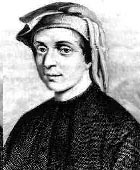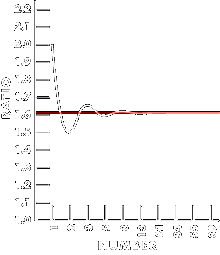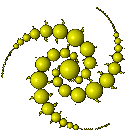Introduction to
Fibonacci Numbers
and the Golden Ratio
![]()
Formula for the Golden Ratio
Phi is the golden ratio.� It is the irrational number that is equal to
(sqrt(5)+1)/2 = 1.618033989...
Using your calculator to find Phi :
 ����� �
����� � ![]() Enter the number 1.
Enter the number 1.
������� ![]() Add 1. Take its reciprocal.
Add 1. Take its reciprocal.
������� ![]() Add 1. Take its reciprocal.
Add 1. Take its reciprocal.
������� ![]() Add 1. Take its reciprocal.
Add 1. Take its reciprocal.
������� ![]() Continue this. You should be converging on the Golden Ratio
Continue this. You should be converging on the Golden Ratio
![]()
The Golden Section
�
 �
�
![]()
The Golden Rectangle

A rectangle whose sides are related by phi is said to be a golden rectangle, or one of the
sides has length 1(x) and the other has length phi(x).
A golden rectangle has the interesting property that, if you create a new rectangle by
swinging the long side around one of its ends to create a new long side, the new rectangle
is also golden.
![]()
The Fibonacci Sequence

��� Leonardo of Pisa, better known as Fibonacci, was born in Pisa, Italy, about 1175 AD. He was known as the greatest mathematician of the middle ages. Completed in 1202, Fibonacci wrote a book� titled Liber abaci on how to do arithmetic in the decimal system. � Although it was Fibonacci himself that discovered the sequence of numbers, it was French mathematician, Edouard Lucas who gave the actual name of "Fibonacci numbers" to the series of numbers that was first mentioned by Fibonacci in his book.� Since this discovery, it has been shown that Fibonacci numbers can be seen in a variety of things today.
��� By charting the population of rabbits, Fibonacci
discovered a number series from which one can derive the Golden Mean.� The beginning
of the sequence: 0, 1, 1, 2, 3, 5, 8, 13, 21, 34, 55... Each number is the sum of the two
preceeding numbers.�
���Dividing each number in the series by the one which preceeds it produces
a ratio which stabilizes around 1.618034���
| Number | Ratio |
| 1 | � |
| 1 | 2.000000 |
| 2 | 1.500000 |
| 3 | 1.666667 |
| 5 | 1.600000 |
| 8 | 1.625000 |
| 13 | 1.615385 |
| 21 | 1.619048 |
| 34 | 1.617647 |
| 55 | 1.618182 |
| 89 | 1.617978 |
| 144 | 1.618056 |
| 233 | 1.618026 |
| 377 | 1.618037 |
| 610 | 1.618033 |
| 987 | 1.618034 |
| 1597 | 1.618034 |
| 2584 | 1.618034 |
| 4181 | 1.618034 |
| 6765 | 1.618034 |
Here are the ratios in the form of a graph...
And 1.618034...= = the Golden Mean.

![]()
 Return to the Golden Ratio page
Return to the Golden Ratio page